
|
![]()
Greatest Films of the 1940s
1940 | 1941 | 1942 | 1943 | 1944 | 1945 | 1946 | 1947 | 1948 | 1949
Title Screen Film Genre(s), Title, Year, (Country), Length, Director, Description 

Bambi (1942), 70 minutes, D: Walt Disney Animation Studios
This highly appealing, popular Disney animated film classic was based on Felix Salten's 1923 book. The legendary film followed newborn baby fawn Bambi as he grew up, experienced the loss of his mother by a hunter, and eventually became a leader of the herd - a magnificent stag known as The Great Prince of the Forest. The maturing of Bambi illustrated the struggles, turmoil, and changes that accompanied the changing of seasons, the passage of time, and life's survival, as he came of age and completed the cycle of life. The film opened with a beautifully-realized, highly-realistic opening birth scene ("the new prince is born") of a young fawn named Bambi in the depths and undergrowth of the forest. As Bambi grew up in coming-of-age scenes, he walked through the forest, and stumbled over his spindly legs and had trouble with his footing when taught how to walk/run by his cute, energetic and lovable rabbit friend Thumper. During Bambi's first winter, Thumper offered lessons for Bambi on how to slide across the ice - causing Bambi to end up spread-eagled. Other friends included bashful skunk Flower, Owl, and many other forest creatures, especially a female fawn named Faline. During Bambi's first visit to the meadow with his mother, he had a glimpse of his father - The Great Prince, who warned the other animals of the approach of Man - a hunter. In the most traumatic scene (with the sound of a gunshot off-screen), Bambi's mother was murdered by Man - a hunter in a snow-covered meadow. The small fawn who had escaped harm gave fearful cries of "Mother, where are you?" during a raging snowstorm. Bambi's buck father's delivered a fateful message about her death to Bambi: ("Your mother can't be with you anymore") - one of the saddest sequences in film history. As Bambi matured into a young stag, wise old Owl delivered a humorous sex-education speech on the power of falling in love ("twitterpatted"); at around that time, both Flower and Thumper found romantic counterparts. Bambi courted pretty young doe Faline, but was interrupted by a rival older buck deer named Ronno, and Bambi was forced to fight for Faline's affection, in an expressionistically-filmed fight sequence. In another terrifying scene during the return and approach of hunters, Bambi protected Faline from a pack of mad and vicious hunting dogs unleashed by Man; although Bambi was wounded, he survived. The forest was destroyed by a chaotic and raging wildfire (carelessly caused by a campfire set by Man), and the animals were helplessly caught in the conflagration as they attempted to flee. In the final springtime scene, a grown Bambi (with the recent birth of twins with Faline) proudly took his place and stood with his 'Prince of the Forest' father, silhouetted against the sky, before he ascended to the top position in the herd when his father stepped aside (and presumably passed on).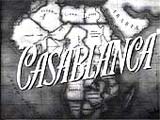





Casablanca (1942), 104 minutes, D: Michael Curtiz
Director Michael Curtiz' best-loved film of all time, a perennial-favorite, was a must-see classic and Best Picture. [Note: The date given for the film was often either 1942 and 1943. That was because its limited premiere was in 1942, but the film did not play nationally, or in Los Angeles, until 1943.] The tale of intrigue, romance, love lost, heroism, and conscience, with well-paced dialogue, a sentimental script, moody and atmospheric sets, and a first-rate cast of memorable characters, was set during World War II in Casablanca (North Africa) at a seedy Algerian saloon/nightclub run by cynical saloonkeeper Richard "Rick" Blaine (Humphrey Bogart), an American expatriate. The Cafe Americain was filled with European refugees, smugglers, thieves and Nazis. Into his joint walked now-married, long-lost-love Ilsa Lund Laszlo (Ingrid Bergman) and her underground Resistance freedom-fighter husband Victor Laszlo (Paul Henreid), who were trying to arrange their escape from the Nazis. They urged him to help support the French Resistance movement. Vivid memories of Rick's and the luminous Ilsa's passionate Paris love affair (just before the Germans occupied the city) ending in betrayal were shown in flashback. Ilsa asked Rick to help them escape to neutral Lisbon, because he had two "letters of transit" - would he give the letters to them, or would she stay with Rick?

Cat People (1942), 73 minutes, D: Jacques Tourneur
Director Jacques Tourneur's classic, low-budget, suspenseful RKO fantasy-horror film was the first film produced by horror film master Val Lewton (and his biggest hit), with moody and sinister atmosphere, eerie sound effects, subtle understatement, interesting camera angles, and a judicious use of shock effects. It was followed by the sequel The Curse of the Cat People (1944), and director Paul Schrader's excessively-violent and erotic remake Cat People (1982) with Nastassja Kinski. A ship-building architect Oliver Reed (Kent Smith) quickly married a mysterious, kitten-faced young bride - a beautiful Balkan artist and fashion designer named Irena Dubrovna (Simone Simon). He became worried when his obsessively 'frigid' wife refused to consummate the marriage - she told him of her fears: "I want to be Mrs. Reed, really. I want to be everything that name means to me. And I can't. I can't. Oliver, be kind, be patient. Let me have time. Time to get over that feeling there's something evil in me." She was obviously haunted by her inner demons, and when incensed could become a deadly black panther - in one exemplary scene, she clawed the sofa with her nails. She believed that she had inherited her Balkan family's ancient, supernatural and evil curse from the homeland - part of a legend that if she became sexually and passionately aroused, she might be transformed into an evil "cat person" or killer panther and hunt and kill her lover. In two frightening horror set-pieces, the jealous feline Irena stalked rival female Alice Moore (Jane Randolph), Oliver's American co-worker assistant, first during Alice's spooky night walk on a Central Park path, and a second similar scene in a YWCA indoor swimming pool. Over time as Oliver's and Irena's marriage became more estranged, Alice fell in love with Oliver, and he announced that he intended to divorce Irena, intensifying her vengeful thoughts and jealousies. In consultation with Irena's treacherous psychiatrist Dr. Judd (Tom Conway), Oliver and Alice were also planning on either having Irena committed to a mental hospital for therapy, or annulling Oliver's marriage. As the film was concluding, Alice and Oliver found themselves in their drafting room office stalked and confronted by a growling panther - Irena in animal form, although Oliver was able to talk Irena into leaving them alone. Her tell tale perfume scent of Lalage identified her. In the film's ending, Dr. Judd - who had diagnosed that Irena's fears came from childhood traumas, foolishly thought he could cure her. After passionately kissing and advancing on Irena during a counseling session in the Reed's apartment, he suffered a predictable fate. She transformed into a black panther and shredded him to death. Irena escaped and fled to the Central Park Zoo, where she approached the cage of a black panther. With a stolen key, she opened the cage door and allowed the animal to suicidally attack her. It knocked her down with its powerful claws, and killed her with the blow. The panther then fled and was killed by a passing car (off-screen). Oliver and Alice raced to the zoo where they discovered the open panther cage and the body of Irena (in the form of a panther) lying nearby. Oliver knelt down to inspect the corpse, and spoke the film's final words to Alice: She never lied to us."



Gentleman Jim (1942), 104 minutes, D: Raoul Walsh
Director Raoul Walsh's entertaining, highly-fictionalized sports biography was about famous heavyweight boxer "Gentleman Jim" James J. Corbett (Errol Flynn). It was loosely based upon James J. Corbett's own autobiography The Roar of the Crowd. The film was set in turn-of-the-century San Francisco. It followed his career from a poor, brawling Irish family, to a lowly job as a bank clerk, then an amateur boxer, and onto the professional level in the 1890s ("the Naughty Nineties") - in the early days of bare-knuckled boxing. He was known for using "scientific" boxing techniques - the first to "dance" around the ring with elusive footwork. He also found time to romance SF socialite love interest Victoria Ware (Alexis Smith), an ambivalent patrician belle who believed he had a "swelled" head, although she supported him. Boxing was being transformed from a lower-class, illegal sport with new Marquis of Queensberry rules - with three minute rounds, one minute between rounds, a ten-count, and no hitting below the belt. The brash, extroverted, stylish and charming Gentleman Jim cheerfully challenged John L. Sullivan (Ward Bond) to an 1892 championship match, revealed in an exciting, action-packed sequence of 21 rounds.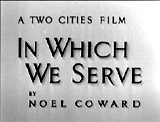



In Which We Serve (1942, UK), 115 minutes, D: Noel Coward, David Lean
This was the first film with a directorial credit by David Lean. The stirring, patriotic (propagandistic), British World War II drama told the story of the lives of the crew of a torpedoed British destroyer HMS Torrin, commanded by Captain E. V. Kinross R.N. (director Noel Coward) (aka Captain 'D'), sunk in the Battle of Crete in 1941 in the Mediterranean. It was based on the real-life experiences of Lord Louis Mountbatten, Captain of the Royal Navy destroyer named HMS Kelly, which was sunk by enemy action early in the war in May, 1941. It was filmed like a black and white documentary, with narration (by Leslie Howard) recounting the historic efforts of the three surviving crew members on a life raft, while they flashed back to memories of their loved ones and service to the ship. The three were: (1) Shorty Blake (John Mills), an ordinary seaman whose girlfriend was Freda Lewis (Kay Walsh), (2) Chief Petty Officer Walter Hardy (Bernard Miles) who was married to ill-fated pregnant Katherine Lemmon Hardy (Joyce Carey), and (3) Capt. Edward Kinross, with two children and wife Alix (Celia Johnson). It featured two stirring speech sequences: an after-dinner speech by Alix, and Kinross' own concluding speech. The film closed with the narrator's words: "God bless our ships and all who sail on them."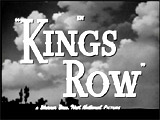

Kings Row (1942), 127 minutes, D: Sam Wood
Director Sam Wood's romantic melodrama was a penetrating look at American morals (rivalries, jealousies, and sordid affairs) in a seemingly peaceful small rural Midwestern (Missouri) town, Kings Row, at the turn of the century. It had a fantastic score by composer Erich Wolfgang Korngold (although unnominated for an Academy Award!). Two young men, future medical student Parris Mitchell (Robert Cummings) and wastrel playboy Drake McHugh (Ronald Reagan, in his career's best and most memorable role) grew up there. Other characters included the town's psychiatrist Dr. Alexander Tower (Claude Rains) and his unbalanced daughter Cassandra Tower (Betty Field), Drake's working class girlfriend Randy Monoghan (Ann Sheridan), and the troubled and sheltered Louise Gordon (Nancy Coleman), daughter of vengeful and moralistic surgeon Dr. Henry Gordon (Charles Coburn). When they reached adulthood, a series of tragic incidents revealed sadism, insanity, moral decay, deceitfulness, and pettiness deceptively hidden in the town. At one point, Drake's dating relationship with Louise was curtailed due to her uptight parents' feelings about him. And then home-schooled, restricted Cassie was poisoned by her father Dr. Tower (who wished to protect Parris from his insane daughter), who then suicidally shot himself (as an act of coverup or regret). Drake, who married girlfriend Randy, was unexpectedly the victim of a brutal Dr. Gordon - both of his legs were amputated following a railroad yard accident, prompting him to ask in the famous line: "Where's the rest of me?" [Note: Future 40th President Ronald Reagan titled his 1965 autobiography with this line.] The film ended with Parris becoming the town's doctor after the death of Dr. Gordon, his truthful support of Drake in a triumphant conclusion, and his romancing of 19 year-old Elise Sandor (Kaaren Verne) who lived with her father in his former residence.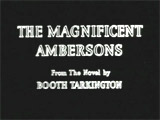

The Magnificent Ambersons (1942), 88 minutes, D: Orson Welles
Producer/director Orson Welles' adaptation of Booth Tarkington's Pulitzer Prize-winning novel was a rich and dramatic period production, although Welles claimed it was "ruined" by the studio's intervention, editing, and censorship. The studio reshot some of the footage, re-edited the film down from the original length - 148 minutes - to 88 minutes. He stated that the studio misunderstood it and mutilated it with cuts, and added a happy ending. It was Orson Welles' first film following his cinematic success with Citizen Kane (1941) a year earlier. Welles both wrote the screenplay and directed this dramatic ensemble film, a favorite of the critics, and its score was composed by Bernard Herrmann. Its rich innovative cinematographic and audio techniques (by Stanley Cortez) were breathtaking, included contrasting light and dark shadows, deep-focus photography, moving dolly and truck camera shots, iris-in iris-out scene closings, and "Welles sound" montages. It was the 25-year saga (spanning two generations) of the decline of a wealthy midwestern Victorian family, the Ambersons, beginning in the pre-industrial period of the 1890s and continuing into the more industrialized 20th century. Patriarchal and rich Major Amberson (Richard Bennett) headed the family, and lived in a modernized mansion with his one daughter Isabel Amberson (Dolores Costello). Young Eugene Morgan (Joseph Cotten) loved Isabel, but she spurned his romantic intentions and married Wilbur Minafer (Donald Dillaway) instead. Her spoiled, tyrannical and arrogant Oedipal youngest son George Amberson Minafer (Tim Holt), was very spoiled and hated by the entire town, who wished for him to receive his "comeuppance." About twenty years later, Eugene (who had married and then was widowed), returned to the town as a successful automobile ("horseless carriage") inventor/manufacturer, accompanied by his pretty grown-up daughter Lucy Morgan (Anne Baxter). Also living in the Amberson mansion was George's unmarried and destitute Aunt Fanny Minafer (Agnes Moorehead). Once Isabel became widowed, Eugene began to court her again, and Lucy and George fell in love - although George schemed to ruin and break up his mother's romantic relationship with Eugene. He prohibited Eugene from seeing his mother - and in part brought about her death and his own estrangement from Lucy. By this time, the Amberson family fortune was disappearing and collapsing due to increasing industrialization, while Eugene's automobile industry was fluorishing. Tragedy struck George (and brought him his "comeuppance") when ironically, he was seriously injured when hit by a car. While in the hospital, he was reconciled with both Eugene and Lucy in his room. In the film's final line of dialogue, Eugene felt blessed by his memory of his true love Isabel: "But it seemed to me as if someone else was in that room. And that through me, she brought her boy under shelter again, and that I'd been true at last to my true love."

The Man Who Came to Dinner (1942), 112 minutes, D: William Keighley
This wacky, side-splitting classic screwball comedy was originally a smash Broadway hit play by George S. Kaufman and Moss Hart, although stagey and dated on screen. A bombastic, cocky, and witty radio celebrity Sheridan Whiteside (Monty Woolley) on a lecture tour fell and broke his leg on slippery ice while in Mesalia, Ohio. The egotistical and abrasive Sheridan was forced to remain during the winter at the house of a local midwestern family - conservative businessman Ernest (Grant Mitchell) and his dotty matronly wife Daisy Stanley (Billie Burke) while he recuperated from his injury, aided by nurse Miss Preen (Mary Wickes). His hosts were driven crazy and relegated to the second floor, and the household was thrown into chaos by his unending eccentric demands, expensive long-distance phone calls, orders to the servants, his loud-mouthed obnoxious manner, exotic animals (an octopus and penguins), and an assortment of oddball friends that came to visit him. His trusted secretary Maggie Cutler (Bette Davis) fell in love with local newspaper man Bert Jefferson (Richard Travis), complicating everything when the conniving Sheridan hired gold-digging, narcissistic actress friend Lorraine Sheldon (Ann Sheridan) to seductively steal Maggie's love interest so that she wouldn't marry and then quit as his secretary. After Sheridan discovered that his leg was actually fine, he bribed Dr. Bradley (George Barbier) to prolong his stay, and used blackmail (the threat to reveal that the Stanley's nutty sister Harriet (Ruth Vivian) was once put away for being an axe murderer) to remain ensconced.


Mrs. Miniver (1942), 134 minutes, D: William Wyler
Director William Wyler's moving, morale-boosting, propagandistic war drama (Best Picture winner, with five other Oscars) and box-office hit from MGM was adapted from the 1939 novel by Jan Struther (first appearing in a serialized newspaper column in The London Times). Its sequel was The Miniver Story (1950, UK) with Greer Garson and Walter Pidgeon reprising their roles. This idealized pro-British film followed the lives of beleaguered but courageous British villagers who faced tremendous trials, hardships, and dangers during World War II and the Nazi aggression. In the town (fictional) of Belham outside of London in the Thames Valley, the upper middle-class Miniver family, headed by architect Clem (Walter Pidgeon) and Kay Miniver (Oscar-winning Greer Garson), were living a bit extravagantly. Clem purchased a new car, while Kay had just gone on a shopping spree in London. In their home (named Starlings), the family welcomed their eldest Oxford-educated son Vin (Richard Ney) back from school. The most important event of the village was the village's annual flower show, with competing roses grown to contend against the perennial winner - the rich head of Beldon Hall manor Lady Beldon (Dame May Whitty). At home, Vin fell in love in Lady Beldon's 18 year-old grand-daughter Carol Beldon (Oscar-winning Teresa Wright). Faced with the onset of war, Vin entered the Royal Air Force (RAF), and was stationed at a local airfield, and was able to assist his boat-owning father Clem in the Dunkirk evacuation (with dramatic footage), to rescue stranded British soldiers. The family remained indomitable during war-time rationings, the trauma of a son fighting in the effort, and terrifying air raids and bombings during the London Blitz requiring retreat to an air-raid shelter. One day, Mrs. Miniver was confronted in her garden by a downed, wounded and threatening German paratrooper (Helmut Dantine) who held her at gunpoint in the house. She remained calm until he passed out and then disarmed him and notified the police. Vin and Carol were married and honeymooned in Scotland. On the day of the flower show awards, Lady Beldon reversed the decision of the judges and declared that a competing entry ("Mrs. Miniver Rose") was the real winner against her Beldon Rose. Kay and Carol were caught in an air raid after leaving the flower show and dropping Vin off at the airfield. On their way to Starlings, they witnessed a dogfight and a German plane crash. Carol was unexpectedly hit by machine-gun fire and soon after died. In the inspiring finale, the courageous villagers assembled in the bombed-out village church (or cathedral) to sing "Onward Christian Soldiers" as proof that there would always be an England. The church's vicar (Henry Wilcoxon) read from Psalm 91 and delivered a moving, patriotic speech ("This is the people's war! It is our war! We are the fighters! Fight it then! Fight it with all that is in us, and may God defend the right!"). Through the partially-open destroyed church roof, the congregation viewed RAF planes flying in a V-formation.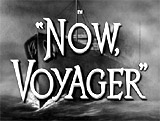

Now, Voyager (1942), 117 minutes, D: Irving Rapper
Director Irving Rapper's sentimental, superb, romantic soap opera and tearjerker featured great performances and a lush Max Steiner score. Its title was based on Walt Whitman's 1900 work Leaves of Grass and the poem "The Untold Want": "Now, Voyager, sail thou forth to seek and find." In the plot, a shy, disturbed, dowdy and lonely middle-aged spinster, Charlotte Vale (Bette Davis) from a prominent Boston family was dominated and tormented by her mean, unloving mother Mrs. Henry Windle Vale (Gladys Cooper). Sheltered ugly duckling Charlotte was helped by kindly psychiatrist Dr. Jaquith (Claude Rains) at his clinic to assist her in blossoming into a swan - she was brought out of her shell to become a lovely, confident young woman. Charlotte took an ocean cruise to discover herself and met handsome, but unhappily married Jerry Durrance (Paul Henreid). They engaged in an affair and entered into an ill-fated romance - because he could never leave his wife. Returning to Boston, she resisted falling under her mother's domination and was liberated from maternal control. Her mother suffered a stroke when Charlotte broke off her engagement to eminent Bostonian Elliot Livingston (John Loder) after meeting Jerry again. Charlotte returned to Jaquith's clinic to resolve feelings of guilt and there identified with and helped Jerry's shy, withdrawn daughter Tina (Janis Wilson), who had been rejected by her mother too. By coming close to Tina as a surrogate mother, she brought Jerry back into her life. The film famously included the memorable scenes of Durrance lighting two cigarettes at once, one for Charlotte.

The Palm Beach Story (1942), 88 minutes, D: Preston Sturges
This was one of the best of Preston Sturges' fast-paced, zany and madcap screwball comedies with snappy dialogue, that was originally titled: 'Is Marriage Necessary?' The frenzied opening credits marriage sequence in 1937 was set to the tune of the William Tell Overture - it was a deliberately puzzling, freeze-frame montage of confusing, mystifying marital vignettes without dialogue (unexplained until film's end, when it was revealed that both fiancee-protagonists were identical twins, and each married the wrong person!). The film officially opened with the end of the five-year marriage in 1942 of struggling, poor, stingy architectural engineer/inventor Tom (Joel McCrea) to his frustrated, slightly wacky, but ambitious wife Gerry Jeffers (Claudette Colbert) who was concerned about growing debts. As she was preparing to leave their Park Avenue apartment in NYC, the couple met the half-deaf Texas "Wienie King" (Robert Dudley), a sausage manufacturer, who was apartment-hunting and offered the destitute couple $700 (for back rent, a new dress and salon visit, and dinner). Shortly after, Gerry departed and boarded a train southbound for posh Palm Beach, Florida, to get a divorce. She theorized that she could make him happy by becoming an "adventuress" - finding a new, wealthy husband (pre-approved and in his "good graces") who might help him realize his ambitions and offer a business partnership to support him. Her actual scheme was to help finance her husband's inventions (and plans for a $99,000 airport) by locating a rich bank-rolling financier. On the train, she encountered a group of tipsy millionaire hunters in the Ale and Quail Club, led by First Member (William Demarest), an unruly group of aging and wealthy sportsmen. On the train in the sleeping berth area, she met the wacky, clumsy and eccentric character of crackpot billionaire J.D. Hackensacker III (Rudy Vallee). J.D. fell madly in love with Gerry and pursued her with wealth and riches. At the West Palm Beach dock, Hackensacker was greeted by his eccentric, carefree, man-crazy, oversexed, fast-talking oddball heiress sister Princess/Countess Centimillia (known as "Maude") (Mary Astor) - the five-time-married Princess Centimillia had been divorced three times. She also met the Princess' flaunted kept-man companion Toto (Sig Arno). Things got more complicated, hilarious and interesting when Gerry's estranged husband Tom arrived in West Palm Beach, Florida (financed by the "Wienie King") to jealously win her back. He took advantage of complicated mistaken identities, when it was deceptively claimed that he was Gerry's brother Captain McGlue. The Princess immediately fell for Tom (Gerry claimed he was not married but "entirely free") and she invited both of them to stay at her mansion. Gerry was immediately worried that Tom might ruin Hackensacker's offer to pay $99,000 for her divorce, and to also bankroll his fanciful plan of a "suspended airport" for $100,000. Ultimately, Gerry announced to Hackensacker that she had decided to return (with McGlue) to her husband back in NYC. Even so, Hackensacker promised to keep his promise as a benefactor to finance McGlue's airport for $100,000. When Gerry revealed the entire masquerade, Hackensacker continued to insist on financing the Jeffers' airport as a good business decision. Due to a lucky coincidence (or weak plot contrivance) that both Tom and Gerry were identical twins, there was a return to the wedding altar sequence in the prologue. Centimillia married Tom's identical twin brother, and Gerry's identical twin sister married Hackensacker. Tom and Gerry stood by on the left as Best Man and Bridesmaid. A caption appeared: "and they lived happily ever after, or did they?"


The Pride of the Yankees (1942), 127 minutes, D: Sam Wood
Director Sam Wood's exceptional sports biography was about one of the greatest baseball players ever - Yankee first baseman Lou Gehrig (Gary Cooper), following his life from his playground days to New York Yankee stardom in the 1920s and 30s. The film chronicled the struggles of his immigrant parents, his early life, his romantic courtship and marriage to Eleanor (Teresa Wright), his sports career, and his courageous fight against a terminal disease. At the height of his career, he was afflicted by a crippling, lethal and incurable muscle-nerve disease - ALS or amyotrophic lateral sclerosis (now bearing his name "Lou Gehrig's Disease") and eventually died. The film opened with his strong-willed, old-fashioned and determined mother (Elsa Janssen), a cook at Columbia University, insisting that her young son Lou Gehrig (Douglas Croft as boy) plan on becoming an engineer like his university-educated Uncle Otto. However, as a Columbia University student and ballplayer, Henry Lou Gehrig (Gary Cooper) made quite an impression by hitting a home run through a window of the school's Athletic Department. He was befriended and approached by Evening Standard sportswriter Sam Blake (Walter Brennan), who told a disbelieving Gehrig that the Yankees team was interested in him. He was soon secretly signed with the Yankees (but kept the news from his mother) - his intention was to help pay for her private hospital bills. Mom Gehrig discovered his career as a ballplayer, and expressed her utter disappointment in him, so he made a suggestion: "Why don't you come out some afternoon and watch me play so you can judge for yourself?" - she eventually acquiesced. Stadium spectator Eleanor Twitchell (Teresa Wright) (nicknamed "the Hot Dog King's daughter") teasingly called rookie Gehrig a "Tanglefoot" when he stumbled over a row of bats in front of the dugout during a game at Chicago's Comiskey Park when he was called for his first appearance at bat - the name stuck: "Mr. Tanglefoot." In the film, Babe Ruth (as Himself) made a cameo appearance as rookie Gehrig's Yankee teammate. There were two opposing opinions about Gehrig: Sam called him "The best of 'em," while rival sportsman Hank Hanneman (Dan Duryea) called Gehrig "the chump of all time" and "a boob with a batting eye." Gehrig soon was courting Eleanor, including taking her to an amusement park where he hit baseballs, won prizes, and loaded her up with a handful of stuffed animals. In a re-enacted scene, Gehrig visited a hospital to see an 8-year old crippled boy named Billy (Gene Collins), who challenged him to hit two home runs in the 1928 World Series game (against St. Louis) that afternoon for the boy. Gehrig fulfilled his promise and hit two homers to win the game - while Billy listened on the radio. Gehrig and Eleanor were married by the Mayor of New Rochelle, NY, and then they sped of ftogether (with a motorcycle police escort) to the ball park for batting practice and a game. Due to his uncurable and debilitating disease of amyotrophic lateral sclerosis (ALS) in his mid-30s, Gehrig slowly began to experience physical deterioration, including muscle weakness, lack of coordination, and slowness that affected his game play. Devastating bad health news (using baseball metaphors) was delivered by Lou Gehrig's doctor (Edward Fielding): "It's three strikes." By this time, older 17 year-old Billy (David Holt) told Gehrig that he had made a full recovery after being inspired by his hero. The sensitive portrayal, endearing and touchingly portrayed, was especially emotional in the final scene - Gehrig's memorable July 4th, 1939 farewell address at Yankee Stadium: "...People all say that I've had a bad break. But today - today I consider myself the luckiest man on the face of the earth." The film's last image was of Gehrig walking slowly by himself (away from the camera) and back to the dugout, to disappear from baseball forever. One could hear the umpire in the background cry out: "Play ball!" as the film ended.



Random Harvest (1942), 125 minutes, D: Mervyn LeRoy
MGM's and director Mervyn LeRoy's sentimental, moving and touching melodramatic romance with an implausible and contrived plot (based on the James Hilton novel) - was about an amnesia victim who forgot the woman he had loved and married. Shell-shocked and mute World War I Army officer (Ronald Colman) suffered from amnesia and was renamed John Smith (or "Smithy"), at the Melbridge County Asylum. The man without a past walked away from the facility during a foggy Armistice celebration in 1918, and in the nearby town of Melbridge, he met music dance hall singer/performer stage-named Paula Ridgeway (British actress Greer Garson), a showgirl for a traveling troupe. After a short romance, they were happily married, moved into a small rented cottage in Devon, and had a son together during a three year period. Before a short trip to Liverpool to apply for a job at the Mercury newspaper, Smithy left Paula with a gift - a glass-bead necklace ("the color of her eyes"). In Liverpool as he crossed a rainy street, a sudden shock to his head from a taxi-cab accident caused him to regain his former memory/life from three years earlier as Sir Charles Rainier (also Ronald Colman) - a Captain in the Wessex Regiment, in Surrey. His past was remembered, but his recent present and life together with Paula was completely forgotten. In his home in Surrey, Charles inherited the family's industrial factory-business following his father's death - and became known as the "Industrial Prince of England." After a few years, Charles' younger step-niece by marriage, Kitty Chilcet (Susan Peters) fell in love with him - her 'uncle.' He agreed to marry her and they were engaged, but he knew deep inside that something was missing from their romance. He suspected that a latch-key hanging from his watch-chain was a vital clue to his past. Paula tracked him down, found him busy at work, reentered his life as Margaret Hansen, and became his devoted private secretary. On the advice of Dr. Jonathan Benet (Philip Dorn), however, she did not reveal her identity or their past life together (or that their son had died), and she annulled their previous marriage. She persistently but patiently hoped his memory would return, and attempted to rekindle their relationship which he couldn't remember. Realizing that Charles was distant, loved someone else, and was not fully committed to marriage with her, Kitty called off the wedding, leaving him depressed. When he was called upon to serve in Parliament as a Conservative Party member, Charles felt the need to be married to assume the vaulted position. He turned to his faithful secretary Paula and asked her for marriage "in friendship" for convenience sake - as a "merger" in name only. Paula accepted Charles' proposal but it was painful for her to have an unemotional, unfulfilled, loveless pairing with him. In the film's concluding sequence, Paula planned to take a holiday and visit South America on a sea voyage, but first decided to spend some time in Devon to remember the wonderful days she had spent there with Smithy. At the same time, Charles visited a factory in Melbridge due to workers agitating for a strike. Slowly, Charles began to retrace his steps and recall his past days in the area. He decided to visit Devon. Both of them happened to be at the gate to their old cottage - where Charles realized the latch-key on his watch-chain opened the front door. Paula softly called out to him at the door: ("Smithy? Oh, Smithy! Oh, darling"). He was jarred into remembering his past life with his true love and became fully reunited with her in the familiar setting.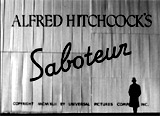

Saboteur (1942), 109 minutes, D: Alfred Hitchcock
Director Alfred Hitchcock's exciting "wrong-man" spy thriller in the WWII era was about the efforts of a suspected and framed saboteur to confront and capture the real fifth columnist and foreign saboteur, in order to clear his name. He went on a breath-taking cross-country road-chase that excitingly climaxed atop the Statue of Liberty (an NYC landmark) with a fall to the death (reminiscent of King Kong (1933)) - symbolizing the victory of democracy over tyranny. The patriotic film was a forerunner to similar themes in Hitchcock's North by Northwest (1959) - (with its many famous US monuments and sites) and also considered a US version of the director's earlier British film The 39 Steps (1935). In the film's opening scene, set at the Stewart Aircraft Works plant in Glendale, CA, suburban LA, aircraft munitions worker Barry Kane (Robert Cummings) found himself accused of sabotage - setting fire to the factory. In the presence of an unfamiliar and unfriendly worker named Frank Fry (Norman Lloyd), Kane was framed and falsely accused of the fiery death of his best friend and co-worker Ken Mason (Virgil Summers). When threatened with arrest, Kane began a journey as a fugitive to locate Fry and clear his name. Clues led him to Deep Springs Ranch in Springfield, California, where he met rich, elitist, cultured, well-respected ranch owner and philanthropist, Charles Tobin (Otto Kruger) with his daughter Mrs. Brown (Kathryn Adams). He confronted the crooked Tobin, accusing him of covering up for the "saboteur" Fry and being mixed up in sabotage at the aircraft plant. Although Tobin had Kane arrested, he escaped from the police by jumping off a bridge. Seeking refuge in the cabin of blind composer Philip Martin (Vaughan Glaser), Kane met Martin's visiting niece - NY billboard blonde model Patricia "Pat" Martin (Priscilla Lane). When she attempted to turn Kane in, he abducted her, and they both ended up in the deserted ghost-town of Soda City, where in a cabin hideout near Hoover Dam (another target), Kane was confronted by two other saboteurs: sinister, sexually-ambiguous Mr. Freeman (Alan Baxter) and Neilson (Clem Bevans). He convinced them to offer him safe passage to NYC. Meanwhile, Pat reported Kane to a local Sheriff after they left - not knowing that the Sheriff was one of the conspirators. In NY, Kane was taken to the mansion of another co-conspirator - wealthy dowager Mrs. Henrietta Sutton (Alma Kruger) who was generously funding the saboteurs. He discovered Pat was being held there too, and that Tobin, who was present, was the major mastermind of the fifth columnists. Tobin feared that their operation at Hoover Dam had been compromised and had to be abandoned, and then announced that Kane was truly an imposter. The villains' next target was the battleship U.S.S. Alaska during its christening at the Brooklyn naval yards. Kane was able to foil the saboteurs' plans at the shipyard, leading to the exciting climax of the film, when both Pat and Kane pursued Frank Fry as he fled and ended up at "Liberty Island" where the Statue of Liberty was located. In a frightening, harrowing scene high up above the water of NY harbor, Kane confronted Fry on the viewing platform on the statue's torch, when Fry lost his balance. Kane reached out to save him by grabbing his coat jacket, but when the jacket sleeve tore along the seam, Fry fell to his death.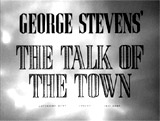


The Talk of the Town (1942), 118 minutes, D: George Stevens
Director George Stevens' intelligent screwball comedy was about a love triangle between a woman, a suspected murderer and a celebrated defense attorney. An avowed anarchist, factory worker Leopold Dilg (Cary Grant) was a fugitive from justice who was falsely wanted and framed by his employer for murder/manslaughter and the arson of the factory. He escaped into the countryside and sought refuge in the attic of a rented summer house, being prepared by sympathetic school teacher Nora Shelley (Jean Arthur) for an unsuspecting vacationing law professor Michael Lightcap (Ronald Colman). Dilg posed as the gardener while he attempted to prove his innocence. The stuffy renter, a strict law-and-order man and a Supreme Court judge appointee, took a liking to the fugitive as they engaged in a series of witty debates and discussed the justice system. The judge defended Dilg from an angry lynch mob in the final trial, clearing him of the charges. The final scene revealed the man who Nora romantically chose (one of the film's two possible endings).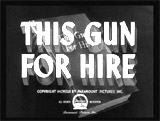


This Gun for Hire (1942), 80 minutes, D: Frank Tuttle
This atmospheric, sinister, film noir mystery from Paramount Studios was an adaptation from Graham Greene's novel A Gun for Sale. It was remade as director James Cagney's Short Cut to Hell (1957). This was the first of four pictures teaming Alan Ladd with co-star Veronica Lake due to their great on-screen chemistry, followed by two other great noirs: The Glass Key (1942) and The Blue Dahlia (1946), and Saigon (1948). Paid professional killer Philip Raven (Alan Ladd), after committing two murders for hire, sought revenge after being double-crossed by double-agent Willard Gates (Laird Cregar) and chemical company president Alvin Brewster (Tully Marshall). Super-sultry, peek-a-boo blonde nightclub singer/magician Ellen Graham (Veronica Lake) was drawn into the hunt after meeting by accident (and sharing a common enemy, Gates) the murderous, cold-blooded hired gun Raven, who admitted he was abused as a child. As their relationship progressed, she attempted to understand the assassin's "soft side." The pair struggled to avoid police who were led by Ellen's boyfriend - police investigator Michael Crane (Robert Preston), as Raven tracked his double-crossing smugglers down to a secret plant where the spy ring manufactured poison gas to sell to Japan - the wartime enemy. In the rousing conclusion, Brewster attempted to kill Raven but died of heart failure, while Raven shot Gates dead. Raven was lethally-wounded by police, but did not shoot Michael because Ellen was helping him. As Raven died, they found the sabotagers' written confession exonerating Raven.

To Be or Not to Be (1942), 99 minutes, D: Ernst Lubitsch
Director Ernst Lubitsch's controversial and classic black comedy satire propagandized and exposed the real nature of the Nazis by lampooning the Third Reich and its leader - a message that used humor to deliver a powerful message against tyranny. [Note: It was similar to Charlie Chaplin's The Great Dictator (1940) in its satirization of the Gestapo, Hitler, and the Nazi movement.] In Nazi-occupied Warsaw in 1939, members of a shabby Polish Shakespearean theatrical troupe were rehearsing their anti-Nazi play Gestapo at Theatre Polsky. The lead egocentric actor was Joseph Tura (Jack Benny) who was co-starring with his flirtatious wife Maria (Carole Lombard in her final screen appearance, before her tragic death in a plane crash). When the authorities censored and shut down the play shortly before the invasion of Poland in the spring of 1940, the actors were only allowed to perform a production of Shakespeare's Hamlet. The hammy and vain Joseph in the lead role gave a priceless imitation of Hamlet. During his oft-delivered "To Be or Not to Be" soliloquy, Tura was often flustered when an audience member in the second row, fugitive Polish bomber pilot-aviator and a member of the RAF in England, Lt. Stanislav Sobinski (Robert Stack) - who was madly in love with Tura's actress wife Maria, would leave to flirt with her in her dressing room. Maria continued to consent to illicit meetings with Sobinski, upsetting her husband. The main plot was the troupe's attempt to prevent Professor Alexander Siletsky (Stanley Ridges) from fulfilling his traitorous mission. He was an imposter-Nazi spy posing as a Polish resistance leader sent from England to Poland, who had in his possession the names of the Polish underground resistance to relay to the Gestapo. To fool the inquisitive Nazis, Tura disguised himself as the bumbling Col. Ehrhardt (Sig Ruman), aka "Concentration Camp" Ehrhardt, to keep Siletsky from ever meeting the real Ehrhardt and exposing names. After Siletsky became suspicious and realized he had been duped, he fled but was shot dead by Lt. Sobinsky. Tura was then able to impersonate and pass himself off as Siletsky in a meeting with the real Ehrhardt. When the masquerade was eventually discovered, the actors had to devise a new ploy. During the Nazi's staging of a show at the theater to honor Hitler, Sobinski, Tura and the other actors dressed as Nazi officials, with Bronski (Tom Dugan) posing as Hitler in order to fool the real Gestapo officers into vacating the theater. Afterwards, Col. Ehrhardt was also led to believe that he was caught having an affair with the Fuhrer's mistress Maria. Feeling shocked for betraying his Fuhrer (actually Bronski), Ehrhardt allowed her to escape and then attempted to shoot himself. She joined the other troupe actors on Hitler's own plane to flee to Great Britain. There, the acting troupe continued to perform Hamlet in Shakespeare's homeland. Again to his surprise, Tura's performance was married by disruptions from an officer leaving the second row during his soliloquy. Remade as a comedy To Be or Not to Be (1983), by director Mel Brooks who took the Jack Benny role, renamed 'Frederick Bronski.'



Woman of the Year (1942), 112 minutes, D: George Stevens
Director George Stevens' witty romantic comedy-drama (and a semi-screwball comedy) about gender roles was originally developed by Garson Kanin (with an Oscar-winning script by Ring Lardner, Jr. and Michael Kanin). This marked the first onscreen pairing of Tracy and Hepburn (the first of nine such films that lasted over a period of 25 years). It was a charming film with superb acting, dialogue and chemistry between the two actors. Successful New York newspaper sportswriter Sam Craig (Spencer Tracy) worked for the same newspaper as celebrated, sophisticated, no-nonsense, career-minded political columnist Tess Harding (Katharine Hepburn). She claimed to know everything but sports and domesticity, so he decided to teach her about the simple pleasures of life. They first met after he angrily responded in a column to her unpopular opinion that baseball games should be suspended during the war. The opposites (or odd-couples) were semi-attracted to each other and married, but found that they had very little in common with each other. She was clueless when he took her to a daytime baseball game - a classic scene. The plot highlighted their strained marital relationship: her inabilities as a housewife although she was a devoted career-woman feminist, while he drank, had typical male expectations and resented her working career. The film included the famous final scene of Tess attempting to cook breakfast (coffee, waffles, and eggs) in his kitchen, with disastrous results. In the film's conclusion, she considered getting divorced, but then was chosen "Woman of The Year."


Yankee Doodle Dandy (1942), 126 minutes, D: Michael Curtiz
Director Michael Curtiz' somewhat fictionalized rags-to-riches, All-American biography and grand musical became one of Hollywood's greatest musicals, and was the highest-grossing film of the year. It was notable for having its energetic tough-guy star, James Cagney, honored as the first Academy Award Oscar for Best Actor for a performance in a musical. Cagney reprised his role as George M. Cohan in The Seven Little Foys (1955). With fancy footwork and memorable flag-waving tunes (such as "Over There," You're a Grand Old Flag," and "Yankee Doodle Dandy"), this was the film that helped to build World War II morale on the homefront. The wartime musical, mostly told in flashback, was about the legendary life of Cohan, the early 20th century vaudevillian song and dance (hoofer) man, prodigious Broadway playwright and songwriter (with at least three dozen-produced Broadway musical shows and more than 300 songs). Born on the 4th of July, the immensely patriotic showman Cohan (James Cagney) related his life story in flashback to President Franklin Delano Roosevelt (Captain Jack Young, only viewed from the back). He was a member of a vaudevillian family including his father Jerry (Walter Huston), mother Nellie (Rosemary DeCamp), and sister Josie (Jeanne Cagney). Through sheer determination and talent, he became the most famous performer, songwriter and screen writer (aka "the man who owned Broadway").